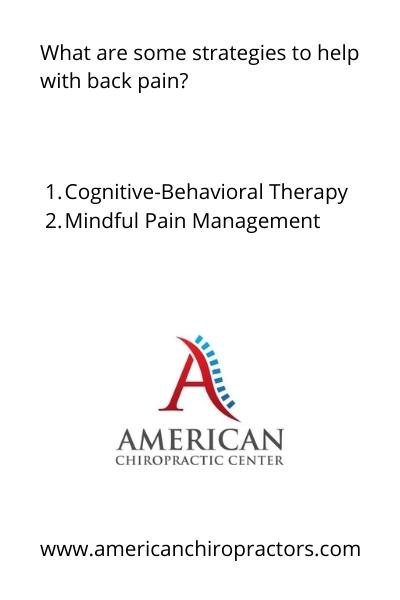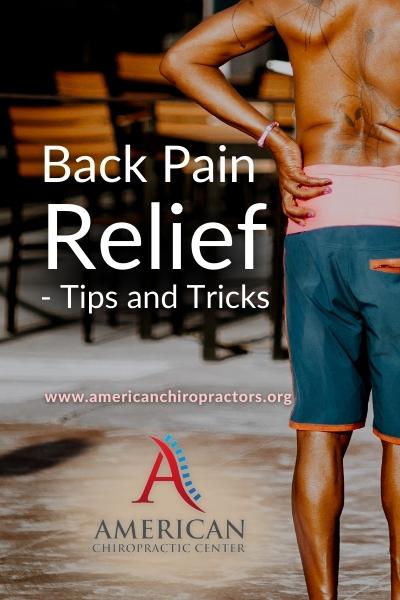Back Pain Relief – Tips and Tricks
Almost everyone will experience back pain at some point in their lives. For some, the pain is chronic and debilitating. If you’re one of the many people looking for relief from back pain, read on for tips and tricks that might help you get on the path to recovery. Whether you’re dealing with a sudden injury or long-term soreness, these tips can help you find relief and start feeling better.
Read More About Back Pain Relief – Tips and Tricks
More Things To Know About Back Pain Relief – Tips and Tricks
Back Pain: Is it Sciatica or Muscle Strain?
Exercising or lifting heavy loads can cause back pain. These activities can sometimes cause disc injury, rupture, or herniation. A herniated disk can cause sciatic nerve irritation, which can lead to back pain, and sometimes, even leg pain.
What is Sciatica?
Sciatica refers to nerve pain that is caused by pressure on the sciatic nerves. The sciatic nerve, which runs from the bottom of the legs to the buttocks, is a large nerve. The sciatic nerve can be pressed on or pinched, causing low back pain that is similar to or worse than shock. Some people feel the pain radiate down to the buttocks, down one leg, and sometimes down to the foot.
Is Your Job Causing Back Pain?
Low back pain can result from a job that requires pulling, lifting, or twisting with your low back. Low back pain can be caused by prolonged sitting in an uncomfortable position. Do you stand for hours at a time? Lower back pain can also be caused by this. It is important to identify if you are at high risk for back pain.
These are some examples of jobs that can result in back pain:
- Airline crew (pilots, baggage handlers)
- Surgeons
- Healthcare workers & nurses
- Taxi and bus drivers
- Warehouse workers
- Construction workers
- Carpet cleaners and carpet installers
- Farmers (agricultural, dairy)
- Police and firefighters
- Janitors
- Mechanics
- Office personnel
Find Back Pain Relief: Lighten Your Bags
A handbag, briefcase, or purse that is too full can cause strain to the lower back. Consider a wheeled briefcase if you have to carry a large load. You can reduce the pressure on your spine by reducing the weight you carry. Make sure your children’s backpacks don’t get too full. This will help keep their backs healthy. Your children’s backs could be in pain if they have a heavy backpack.
Fix Your Poor Posture
When we stand straight up and don’t slouch, our backs provide optimal support. Low back pain can be prevented by sitting properly with support for the lower back, shoulders back, and even a footrest. Standing upright while balanced can reduce the chance of low back pain.
Get Better Sleep
You may have difficulty sleeping if you have back pain. This can lead to a vicious circle. If you don’t get enough rest, it could make your back pain worse. Bad sleeping habits can lead to back pain. Lay on your back. To keep your spine neutral and reduce strain on your back, place a pillow between your knees. Slide a pillow between your knees if you have to lie on your back. Sleep on a mattress that is firm and comfortable.
Exercise Your Core
Your lower spine is supported by the muscles of your back and abs. These muscles are not given enough exercise during the day.
Many simple exercises can be done in as little as 20-30 minutes and included in your daily routine. Even if you’re just starting out, a simple 30-minute exercise on an exercise ball will strengthen your core muscles.
Engage Your Brain
Pain specialists know that pain is not just a feeling. How your brain interprets pain signals and how it processes them plays a significant role in how you feel pain.
You can learn skills to help your brain reduce pain signals or ignore them. Below are some strategies that may prove useful to you:
Cognitive-Behavioral Therapy – This therapy can help you think differently about your pain or teach you new ways to manage it.
Mindful Pain Management – Mindfulness and meditation can help to reduce pain sensations. This is typically achieved by slow controlled breathing and focusing your mind. It may also aid in relaxation. Many videos online are free and can be used to help you get started in mindfulness and relaxation.
You may be able to exert some control over your pain by learning mind-body techniques.
Do Activities that Make You Happy
Chronic back pain can cause havoc in your life. It can affect your relationships, finances, as well as your ability to do work and home. You can reduce stress by finding activities that make you happy.
People find that even 3 simple things can make their pain less severe. These include a cup of comforting tea, a call to a friend, walking the dog, or a 30-second hug from a loved one.
Manage Your Stress
Stress can cause muscle tension, spasms, and pain in the back. A person may try these stress-relief methods if they feel that long-term stress, trauma, or other traumatic events have caused back pain.
Deep Breathing – Deep breathing for several minutes can help calm your body’s stress response.
Guided Imagery – Focusing on certain mental images can help you relax. A study showed that guided imagery and music can reduce work-related stress.
Meditation on Mindfulness – One study found that mindfulness meditation reduced back pain. Mindfulness is a way to be aware of your body and use meditation techniques to help with the pain.
Progressive Muscle Relaxation – This is done by relaxing and tensing muscles, focusing on one group of muscles at a time. Lying down on one’s back, a person can begin with their feet and work their way up to their shoulders.
Yoga – Yoga is a practice that focuses on specific breathing techniques and helps with relaxation. Yoga was found to be a great stress management tool in one review.
There are many apps that can be downloaded to help you with meditation and relaxation.
Stretch Your Hamstrings
Having tight hamstrings often causes lower back pain. Tight hamstrings can cause lower back pain by stressing your sacroiliac and lower back muscles. You should stretch your hamstrings carefully, at least twice a day, for between 15 and 30 seconds.
Use a Pain-Relief Cream
There are many pain relief creams available online and in pharmacies. Capsaicin creams may help with pain relief. This compound is found in hot peppers. Capsaicin cream was found to be effective in relieving osteoarthritis pain according to one study. Menthol can also temporarily dull back pain by cooling down pain-relief creams. A study has shown that menthol can be applied to the skin to reduce pain receptors. But too much of it can increase pain sensitivity.
Use Arnica for Low Back Pain Relief
Arnica can be used as a homeopathic remedy to treat minor injuries, muscle pain, swelling, and swelling. Arnica gels and creams are available at many pharmacies. You can also buy it online.
Although there is not much scientific evidence to support Arnica’s effectiveness, some people may find Arnica helpful. A case study showed that arnica combined with acupuncture or massage helped to relieve osteoarthritis pain.
Ice Pack and Heat Therapy
Do not underestimate the benefits of a cold and/or heat packs for pain relief. The use of cold therapy can reduce inflammation and pain. You can wrap ice in a towel, frozen peas, or use a cold gel to reduce inflammation and pain. Keep at least one layer between you and the ice/cold packs.
Heat therapy can improve blood flow, relaxation, pain relief, and blood circulation. There are many types of heat therapy. To find the best heat therapy for you, it’s best to experiment with several. Warmth can be brought to your lower back by taking a warm shower or bath or soaking in a hot bathtub.
To protect your skin, use ice or heat packs only for 15 to 20 minutes. Give yourself at least two hours rest between each application. Avoid sleeping with a heating pad, frozen pack, or heating pad as they can cause permanent skin damage.
These overlooked solutions may help you find lasting relief from lower back pain.
Over the Counter Medication
Non-steroidal anti-inflammatory drugs (NSAIDs), and acetaminophen are both over-the-counter pain relief options that can help back pain. Each has side effects and some people may not tolerate them. Before you start taking pain relief medications, consult your doctor. Don’t assume that medication will solve your pain problem. Research shows that you will likely need multiple types of treatment.
Prescription Pain Relievers
NSAIDs and opioid medications are sometimes necessary for people with chronic pain. To avoid overdosing with certain active ingredients, it is important to discuss your medication with your pharmacist or doctor. To ease muscle spasms, your doctor may prescribe muscle relaxants.
Physical Therapy
Physical therapists can help you sit, stand, and maneuver in a way that aligns your spine and reduces strain on the back. You can also learn specialized exercises to strengthen your core muscles, which support your back. Strong core muscles are a great way to avoid back pain in the long term. Research shows that back pain is lessened when you have more strength, flexibility, endurance, and endurance. But it takes time.
Preventing Low Back Pain
You can reduce your chances of developing back pain by exercising regularly and not just irregularly.
A low-impact exercise program is recommended after prolonged inactivity. Walking, swimming, and stationary biking for 30 minutes a day can help increase muscle strength, flexibility, and protect the lower back from injury. Regular stretching can loosen muscle tension, strengthen core muscles, and improve posture to help you have a healthier back.
Exercises That Can Cause Low Back Pain
Most sports injuries to the back result from sprains or strains in the muscles around the spine. Severe conditions and complications may present with similar symptoms as a simple sprain, strain, or routine injury. Most sports injuries are caused by repetitive overuse of the spine, either by twisting, compression or flexion. Low back pain can be caused by high-impact sports like running, football and volleyball. Low back pain can also be caused by repetitive twisting activities like golf.
Tips to Strengthen Your Back
Low back pain can be prevented by stretching and flexing. Any program that you consider should be reviewed with your doctor.
Simple Low Back Exercises
Ankle Pumps: Place your feet on the ground and lift your ankles.
Heel Slides: Place your head on the back, bend and straighten your knees.
Single Knee to Chest Stretch: Lie down flat on your back, and pull your knee towards the chest.
Wall Squats: Place your back against the wall and place your knees over your ankles. Keep your abdominal muscles tight and press down on the wall. For five seconds, hold the position.
Do I Need to See a Chiropractor for My Back Pain?
Chiropractic and osteopathic doctors use spinal manipulation for lower back pain relief in select patients. Spinal manipulation uses hand pressure to reduce pain intensity and relax injured muscles. Temporary relief can be achieved by using weights or pulleys to stretch and lengthen the spine. These techniques do not address the underlying causes of lower back pain but will provide temporary relief.
If you have acute low back pain or even chronic low back pain, make sure to take the necessary steps to relieve that pain. Live a healthy lifestyle, maintain a healthy weight, engage in physical activity, seek home remedies and relaxation techniques, and if that still doesn’t relieve pain, try going to a physical therapist and seek alternative treatments.
You may also find certain medications that can lessen pain or essentially block pain signals. For severe pain in a certain affected area, seek a physician.






















